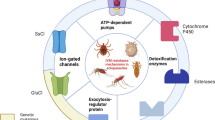Summary
In recent clinical trials acithromycin in combination with artemisinin derivatives proved to be a promising combination therapy with indifferent to synergistic interaction. The aim of the present study was the assessment of optimal combination ratios for dihydroartemisinin and azithromycin for the treatment of uncomplicated falciparum malaria. The study was conducted in Bandarban, in Southeastern Bangladesh. Plasmodium falciparum isolates collected as part of a clinical trial were cultured for 72 hours. Samples were analyzed using the HRP2 drug sensitivity assay in fixed combinations and checkerboard assays. An indifferent mode of interaction was found for the 1 : 500 combination of dihydroartemisinine and azithromycin. The sum fractional inhibitory concentrations (SFICs) at IC95 ranged from 0.89 to 1.16 for combination ratios of 1 : 500 and 1 : 5000, respectively. A trend towards lower SFICs was observed with rising inhibitory concentrations (i.e. at IC90 and IC95). Correlation analysis suggests a different mode of action for azithromycin as compared to traditional antimalarials.
Zusammenfassung
In jüngsten klinischen Studien erwies sich Azithromycin in Kombination mit Artemisininderivaten als vielversprechende Kombination für die Behandlung der unkomplizierten falciparum Malaria mit in-differenter bis synergistischer Interaktion. Das Ziel der vorliegenden Studie war die Ermittlung von optimalen Wirkstoffverhältnissen für Azithromycin und Dihydroartemisinin für die Behandlung der unkomplizierten falciparum Malaria. Die Plasmodium falciparum Isolate wurden im Rahmen einer klinischen Studie in der MARIB Feldstation im Bandarban Sadar Hospital, im Südosten Bangladeshs gewonnen und für 72 Stunden kultiviert. Die Analyse erfolgte mittels des HRP2 Medikamentensensibilitätstest. Die Auswertung der Daten ergab eine im Großen und Ganzen indifferente Interaktion für Dihydroartemisinin in Kombination mit Azithromycin mit einem optimalen Konzentrationsverhältnis bei einem Mischungsverhältnis von etwa 1 : 500. Die summarischen fraktionellen Hemmkonzentrationen (SFICs) lagen bei 95 prozentiger Hemmung zwischen 0,89 und 1,16 für die Mischverhältnisse 1 : 500 und 1 : 5000. Ein deutlicher Trend zu niedrigeren SFICs zeigte sich bei höheren Hemmkonzentrationen. Die Korrelationsanalyse legt für Azithromycin einen von den bisher verwendeten Therapeutika unterschiedlichen Wirkmechanismus nahe.
Similar content being viewed by others
Literatur
White NJ (2004) Antimalarial drug resistance. J Clin Invest 113 (8): 1084–1092
Noedl H, Wongsrichanalai C, Wernsdorfer WH (2003) Malaria drug-sensitivity testing: new assays, new perspectives. Trends Parasitol 19 (4): 175–181
van den Broek IV, van der Wardt S, Talukder L, Chakma S, Brockman A, Nair S, et al (2004) Drug resistance in Plasmodium falciparum from the Chittagong Hill Tracts, Bangladesh. Trop Med Int Health 9 (6): 680–687
van den Broek IV, Maung UA, Peters A, Liem L, Kamal M, Rahman M, et al (2005) Efficacy of chloroquine + sulfadoxine-pyrimethamine, mefloquine + artesunate and artemether + lumefantrine combination therapies to treat Plasmodium falciparum malaria in the Chittagong Hill Tracts, Bangladesh. Trans R Soc Trop Med Hyg 99 (10): 727–735
Thriemer K, Haque R, Wagatsuma Y, Salam MA, Akther S, Attlmayr et al (2006) Therapeutic efficacy of quinine plus sulfadoxine-pyrimethamine for the treatment of uncomplicated falciparum malaria in Bangladesh. Am J Trop Med Hyg 75 (4): 645–649
Noedl H, Krudsood S, Chalermratana K, Silachamroon U, Leowattana W, Tangpukdee N, et al (2006) Azithromycin combination therapy with artesunate or quinine for the treatment of uncomplicated Plasmodium falciparum malaria in adults: a randomized, phase 2 clinical trial in Thailand. Clin Infect Dis 43: 1264–1271
Krudsood S, Buchachart K, Chalermrut K, Charusabha C, Treeprasertsuk S, Haoharn O, et al (2002) A comparative clinical trial of combinations of dihydroartemisinin plus azithromycin and dihydroartemisinin plus mefloquine for treatment of multidrug resistant falciparum malaria. Southeast Asian J Trop Med Public Health 33 (3): 525–531
Na-Bangchang K, Kanda T, Tipawangso P, Thanavibul A, Suprakob K, Ibrahim M, et al (1996) Activity of artemether-azithromycin versus artemether-doxycycline in the treatment of multiple drug resistant falciparum malaria. Southeast Asian J Trop Med Public Health 27 (3): 522–525
Miller RS, Wongsrichanalai C, Buathong N, McDaniel P, Walsh DS, Knirsch C, et al (2006) Effective treatment of uncomplicated Plasmodium falciparum malaria with azithromycin-quinine combinations: a randomized, dose-ranging study. Am J Trop Med Hyg 74 (3): 401–406
Noedl H, Attlmayr B, Wernsdorfer WH, Kollaritsch H, Miller RS (2004) A histidine-rich-protein 2-based malaria drug sensitivity assay for field use. Am J Trop Med Hyg 71: 711–714
Noedl H, Bronnert J, Yingyuen K, Attlmayr B, Kollaritsch H, Fukuda M (2005) Simple histidine-rich protein 2 double-site sandwich enzyme-linked immunosorbent assay for use in malaria drug sensitivity testing. Antimicrob Agents Chemotherapy 49 (8): 3575–3577
Noedl H, Wernsdorfer WH, Miller RS, Wongsrichanalai C (2002) Histidine-Rich Protein II: a Novel Approach to Malaria Drug Sensitivity Testing. Antimicrobial Agents and Chemotherapy 46 (6): 1658–1664
Ohrt C, Willingmyre GD, Lee P, Knirsch C, Milhous W (2002) Assessment of azithromycin in combination with other antimalarial drugs against Plasmodium falciparum in vitro. Antimicrob Agents Chemotherapy 46 (8): 2518–2524
Noedl H, Krudsood S, Leowattana W, Tangpukdee N, Thanachartwet W, Looareesuwan S, et al (2007) In vitro antimalarial activity of azithromycin, artesunate, and quinine in combination, and correlation with clinical outcome. Antimicrobial Agents and Chemotherapy 51 (2): 651–656
Author information
Authors and Affiliations
Corresponding author
Rights and permissions
About this article
Cite this article
Vossen, M., Haque, R., Starzengruber, P. et al. In vitro Interaktionsstudien mit Azithromycin und Dihydroartemisinin in Plasmodium falciparum Isolaten aus Bangladesh. Wien Klin Wochenschr 119 (Suppl 3), 71–75 (2007). https://doi.org/10.1007/s00508-007-0863-7
Issue Date:
DOI: https://doi.org/10.1007/s00508-007-0863-7




